by Heather Kent | Aug 15, 2014
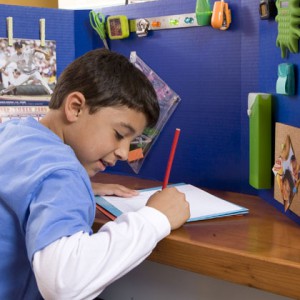
Photo courtesy of Family Fun Magazine
These days, children as young as kindergarten age can have homework. Getting your child to do homework during the hectic evening hours is frustrating for many busy parents, but setting up a simple homework center can make it easier.
- Select a location for your child to do homework- an eating nook in the kitchen or at the dining room table are good ideas. Try to keep your homework center location clutter free, and well lit. If you have younger children, they may need a booster seat in order for them to sit at the proper height for writing. Remember that children (even teens) need supervision and assistance with homework, so planning a homework area in a common location is more convenient so that parents can also work on other tasks such as preparing dinner. If the homework center is set up in a bedroom or loft space, you will need to plan on checking in from time to time to monitor their progress. Younger children or children with learning disabilities will need additional, or more frequent help.
- Gather Supplies– it is helpful to have a plastic cleaning caddy, tub, or recycled shoe box filled with supplies that your child might need for completing his homework, so that you don’t waste time looking for supplies each day. Recommended supplies include: pencils/pencil sharpener or mechanical pencils, erasers, colored pencils/markers, crayons, stapler/extra staples, index cards, highlighters, scotch tape, glue stick, dictionary, thesaurus, atlas or globe. Have your child decorate the caddy or box with stickers, paint, glitter glue, or other decorations.
- Limit Distractions– it is best to limit television and stereo/iPod during homework time. If you have more than one child, or a child with ADD/ADHD, you might also want to consider a study carrel. Study carrels limit distractions and help children focus on their work. Your child can help create a study carrel and customize it to his own needs with a tri-fold display board (readily available for less than $5.00 at office supply and big box stores). One display board will make two study carrels. Step by step instructions for creating one can be found online at: http://spoonful.com/crafts/homework-central courtesy of Family Fun Magazine.
- Set up a Reward System– reward your child for getting their homework completed in a timely and neat manner. You can set up a sticker system for earning small prizes, TV or video game time, or even to see an upcoming animated movie or for a family bowling night.
As your family prepares for back to school, don’t forget that the 4-H year will be coming to a close at the end of this month. Enrollment in Florida 4-H beings August 23rd. To re-enroll, visit: http://florida.4honline.com or contact your local UF/IFAS County Extension Office.
Next Week: School Lunch and Snack Ideas that are “Out of the Box”
by Heather Kent | Aug 8, 2014
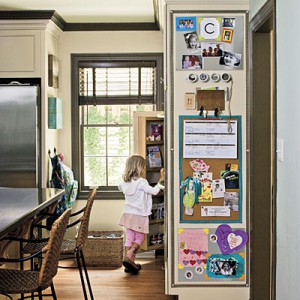
Home Command Center idea from SouthernLiving.com
As summer comes to a close, many parents are overwhelmed getting ready for “back to school” let alone the new 4-H club year! Over the next few weeks, we will share some timely tips for busy 4-H parents so that you are less likely to miss a school event, practice, 4-H meeting, or deadline. One of the best ways to stay organized and on track is to have a home communication center.
The first thing you will need to decide is where to place your command center. It should be located in a well-traveled area of your home, such as a kitchen, entry way, den, or family room. You can use a blank wall space that you walk by several times a day, a corner of your kitchen countertop, or even a cabinet. There are lots of ideas on Pinterest and organizing blogs that can inspire you.
Once you have determined a location, consider which elements you want to include in your command center. Every command center needs at least three items:
- Calendar– Some families have a calendar for each member of the family, but for smaller families, it is recommended to use one calendar and assign each family member a color, and write their activities in that color on the calendar. You can use a traditional paper calendar or a dry erase calendar. Remember that if you use a one-month dry erase calendar, you will need another calendar or space to put important future appointments.
- Folders or cubbies– You can use wall mounted folders/magazine holders, or file folder holders that sit on a counter or desk. One folder per family member to contain important homework assignments, 4-H project information, receipts, bills, and so forth. Folders are not a permanent filing solution- they are only to contain information that is not ready to be filed, or information that that you need to access frequently such as a school lunch menu, or soccer practice schedule.
- Message Board– Bulletin boards, dry erase boards, chalk boards, or magnetic boards work well for reminders, important phone numbers, directions to a birthday party, grocery lists, and other bits of information that you do not want to put in a folder or on a calendar. If you are limited on wall space, consider installing self-adhesive cork board to the inside of a kitchen cabinet located above or next to your command center.
Other items that you might want to include in your command center: chore charts, weekly/monthly menu plans, a hook for keys, backpacks, jackets, and a charging station for cell phones.
Last but not least, think about how you want your center to look. You can keep it very basic and functional, or you can design it to coordinate with the rest of the room’s décor/color palette. Much of the look and feel of your command center will depend on your budget. Many companies sell coordinating command center components in a variety of finishes that you can mix and match, but they are more expensive. A less expensive alternative is to purchase the individual elements that you need from your local office supply or big box store, and then paint them to match, or cover them with contact paper in a fun print or color. Your command center can be as simple or elaborate as you prefer- you are only limited by your creativity!
As your family prepares for back to school, don’t forget that the 4-H year will be coming to a close at the end of this month. Enrollment in Florida 4-H begins August 23rd. To re-enroll, visit: http://florida.4honline.com or contact your local UF/IFAS County Extension Office.
Next Week: Setting up a Homework Center
by Heather Kent | Jul 30, 2014

Couch Camping with Cloverbuds
Sometimes, kids are just too young to fully enjoy the overnight camping experience. In 4-H, children need to be a least 8 years old (by September 1st) to attend overnight camps. Couch camping is a great way for Cloverbuds (4-H members between the ages of 5 and 7) to explore the world of camping without the mosquitos, rain, or anxiety of being away from home. Couch camping is also a great alternative when your work schedule or the weather do not allow for a “real” camping trip. Below are three simple tips for getting the most out of your next couch campout!
- Atmosphere– Push the furniture against the wall and set up a tent in your living room. Bring out the sleeping bags, pillows, and camp chairs. String white lights over the tent to simulate stars and let the kids decorate empty paper toweling tubes to simulate logs for the campfire. Red lights or tissue paper make great flames. Download sounds of frogs, crickets, and other forest sounds to play in the background. Then all that’s left is to dim the lights and turn on your battery operated lanterns.
- Food– Camp food is a must! Serve hotdogs or your favorite campfire meal and don’t forget the popcorn and s’mores. To make s’mores indoors, simply place your marshmallows, graham crackers, and chocolate in the microwave for 10-20 seconds. The marshmallows and chocolate will get gooey- the perfect consistency for s’mores. If you are worried about stains on the carpet, place a tarp or plastic tablecloth under your “campfire” eating area.
- Activities– This age group will really enjoy pretend play. Have toy fishing poles and nets for them to fish with. Use stuffed animals (such as frogs, bears or squirrels) and allow them to “track” the animals. Let them build a campfire with wooden blocks. Make shadow puppets or try flashlight reading. Build a simple birdfeeder out of a pinecone, peanut butter, and birdseed. You can also try a scavenger hunt or campfire BINGO. 4-H campfire songs are also fun, but we do not recommend ghost stories for this age group.
If you enjoy working with 5-8 year olds, consider becoming a 4-H Cloverbud Volunteer. There will be a training for Cloverbud Volunteers and preschool teachers on January 24th in Marianna, FL from 10AM-3PM. Participants will receive teaching kits for working with 5-7 year olds, and CEUs will be available for teachers. For more information, contact Heather Kent at hckent@ufl.edu.
by Heather Kent | Jul 23, 2014
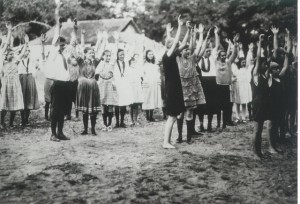
Physical exercise was an important component of 4-H Camp, even back in the 1930’s!
For many Florida 4-H members, attending a week-long overnight camp at one of the four Florida 4-H Camping centers is a rite of passage. For nearly 90 years, 4-H youth and volunteers have been making their way to the shores of the Choctawhatchee Bay, home to Florida’s oldest camp, Camp Timpoochee.
Camp Timpoochee was started in 1926 when Jackson County 4-H members auctioned off their poultry flocks at the train station in Marianna to raise money for the camp. During the early years, many 4-Hers paid for their week of camp by bringing chickens and other goods. In those days, camp was a vacation from working on the farm in the summer heat and a chance to meet other youth. Over the last decades, several 4-Hers have even met their future spouse at 4-H camp!
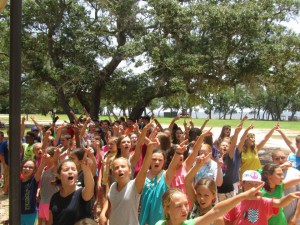
Youth still enjoy many of the same activities at Timpoochee, but they also have opportunities to build robots, rockets, and GPS units.
Today, camp is still a safe environment where youth feel like they belong, learn independence, mastery, and generosity towards others. It is also a vacation from the peer pressure and bullying that many youth experience at school. One camper shared “I love coming to 4-H Camp, because it is the one week where I feel like I belong and no one makes fun of me or puts me down.” Other campers look forward to camp because it is an opportunity to do things they don’t normally get to do, like fish, shoot a bow and arrow, build and launch a rocket, or paddle a kayak.
How do we ensure that Camp Timpoochee will be around for future generations? It pretty much all boils down to volunteers. As long as there are volunteers working with Extension to support 4-H clubs and youth, donors will continue to support the work they do to make sure that future generations can learn valuable life lessons at camp.
How many generations of your family have attended 4-H Camp Timpoochee or Cherry Lake? Let us know in the comment box below. Feel free to share your favorite thing about camp on our blog or on Facebook. The family with the most interesting story will be featured in a future blog post!
To learn more about the Florida 4-H camping program, visit http://florida4h.org/camps_/. If you have a special place in your heart for 4-H Camp Timpoochee, consider serving as a 4-H Camp Volunteer, or even making a donation so that youth can enjoy the same experiences as generations before them. Florida 4-H Camps are also available to host family reunions, church retreats, corporate functions, and other events. You can help support Camp Timpoochee by scheduling your next event there. For more information, contact Heather Kent at hckent@ufl.edu.
by Heather Kent | Jul 16, 2014
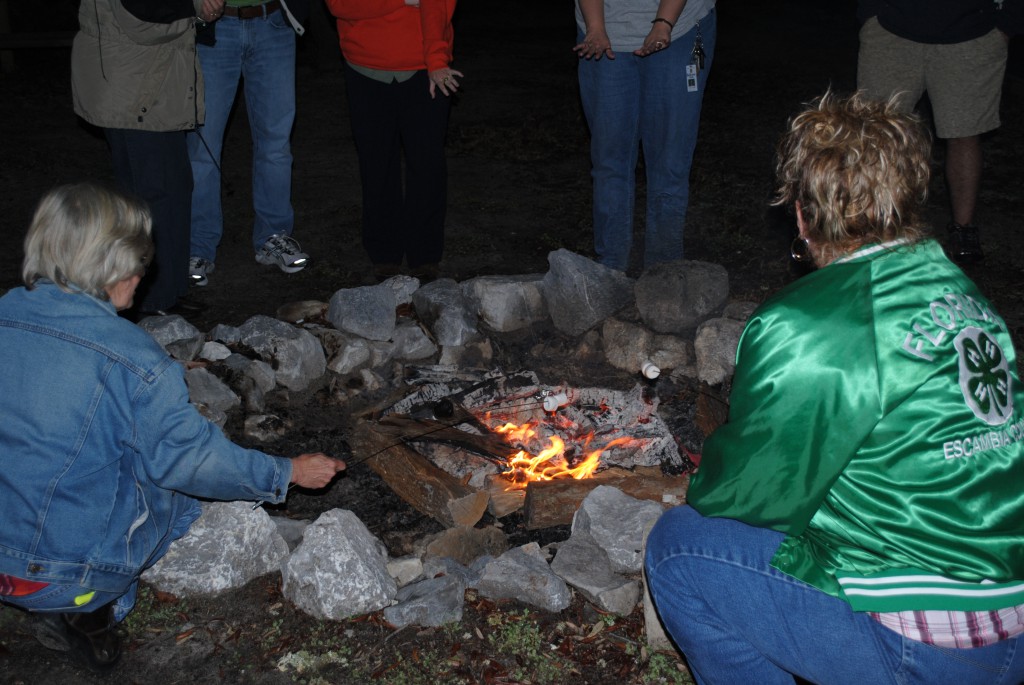
4-H Volunteers cook s ‘mores over the campfire at Camp Timpoochee
For many families, summer is synonymous with camping. Whether you are at 4-H Camp, a family camping trip, or a stay-at-home-vacation, cooking over the campfire is a fun (and yummy) activity that the whole family can enjoy. In support of the 4-H initiative for Healthy Living, we have selected 24-hours’ worth of delicious and nutritious food that your family can enjoy over your next campfire.
Breakfast Camporitos– this is a campfire version of breakfast burritos. Dice and sauté the veggies of your choice (we recommend onions, bell peppers, tomatoes, and/or potatoes). Place sautéed veggies in a bowl for later. Next, scramble your eggs. To assemble, spoon veggies and eggs onto a tortilla, then sprinkle with cheese. You can add a bit of salsa if preferred. Wrap your tortilla burrito style, then wrap the entire burrito in foil. Camporritos can be prepared and assembled in advance, and stored in a cooler until breakfast time. To serve, place the foil packets over the campfire for 5-7 minutes until the cheese is melted and the burritos are thoroughly heated through. Serve with seasonal fruit and orange juice or milk.
Campfire Calzones (for lunch or dinner)- use store-bought pizza dough or your favorite recipe. On a 2-foot section of aluminum foil, roll out a portion of pizza dough into a circle the size of a paper plate. Next, spoon on some tomato or marinara sauce, sprinkle with basil and oregano. Working on just one half of the circle, sprinkle on 1/3 cup of mozzarella cheese and add your favorite pizza toppings (we recommend pepperoni or ham, spinach, olives, and mushrooms). Fold the half of the dough without toppings over, and crimp the edges tightly, next fold over the aluminum foil, creating an envelope and crimp the foil together securely to make a foil packet. Place your packet over the grate or coals of your campfire. Bake your calzone 5-10 minutes on each side, depending on the temperature of your fire.
Campfire Veggie Dip (a tasty snack)- for this recipe, you will need a large, empty can that has been washed out. In the clean can, layer the following ingredients: Black beans, shredded cheese, salsa, fat free refried beans, and fresh cilantro. Place the can on the grate over your campfire and allow the contents to heat up. Once the cheese is melted and heated through, remove the can. Wrap the can with a festive bandana and serve the dip with carrots, bell pepper, broccoli, celery, or tomatoes.
Campfire Chili and Corn Bread in a Jar (for lunch or dinner)- in a clean mason jar, ladle a cup or two of your favorite chili. On top of the chili, place about 1/3 cup of your favorite cornbread dough (made from scratch or use a mix). You can screw on the jar lids to make the chili easier to transport. Place your jars over the campfire and allow them to back for 30-45 minutes, until a toothpick inserted into the cornbread comes out clean. By then, your chili should be thoroughly heated through. If you prefer, you can assemble this recipe in a large Dutch oven, rather than in individual jars.
Desert Campfire Cones– Stuff a waffle cone or bowl (not the regular sugar cones) with diced fresh strawberries and bananas, along with mini marshmallows, chocolate chips, or even peanut butter chips. Wrap your cone or bowl with aluminum foil, and place over the grate of the campfire. Rotate the foil packet every 1-2 minutes. After 5-7 minutes, your cone should be ready to eat. If you are camping in the fall, try a variation of this technique with diced apples and caramel sauce.
To learn more about the Florida 4-H Program and our Healthy Living Initiative, visit http://florida4h.org. If you are interested in volunteering or donating to 4-H, contact Heather Kent at hckent@ufl.edu.






